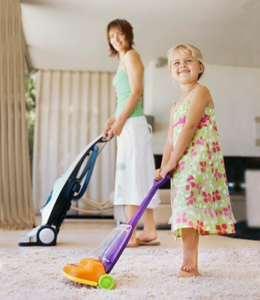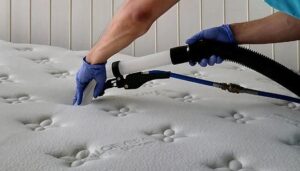Carpets collect dirt, dust, and debris that can lead to premature wear and tear. Carpet Cleaning Fayetteville AR eliminates these elements and help your carpets last longer.
From spillages to muck brought into your home on shoes and pets, many types of stains can be minimized or removed by professional carpet cleaners. They use specialized equipment and detergents that can get your carpets looking almost brand new.

Allergens, bacteria, and soil gather in carpets and can be difficult to remove. A regular deep clean of your carpets ensures that these elements don’t become trapped and cause health problems. A good deep clean also helps to extend the life of your carpets. If you don’t have a professional cleaner available, there are many products that you can use to get the job done quickly and efficiently.
Powder cleaners work well on spot stains and day-to-day dirt and don’t require much water to be used. Simply sprinkle the powder on the stain, leave it for a specified time and then vacuum it up. These are considered more environmentally friendly than other cleaners that rely on water and may not be as effective.
Liquid cleaners can be poured into a carpet cleaning machine or applied directly to the stain with a brush, depending on the type you buy. They are made to tackle all types of stains and are usually available in different pH levels depending on the type of fibre you have. Synthetic fibres can usually tolerate solutions closer to 0 or 10, while natural fibres may be more sensitive.
These cleaners often contain phosphates and other harmful chemicals that can promote algae growth in waterways, kill fish and damage the environment. Many also use artificial fragrances that can cause respiratory issues and allergic reactions. You should try to avoid these and look for SOA-certified solutions that are free from such ingredients.
Vacuuming frequently, ideally multiple times per week, can keep your carpets looking great and remove most dirt particles before they have a chance to sink in. Using doormats and taking off shoes inside the house can help prevent the build-up of dirt and grime too.
It is recommended that you professional carpet cleaning every 12 to 18 months. This will remove any embedded dirt that could damage the fibers, which can reduce their lifespan and lead to re-soiling. It’s best to use SOA-certified cleaners that are free from harsh ingredients and are safe for your family. A reputable service will vacuum and move any furniture out of the way to make sure your carpets are cleaned thoroughly.
Carpeting adds a touch of sophistication to a room and offers great warmth and comfort. However, it can be a trap for dirt, germs and bacteria. The oily residue that dries on the floor from people’s shoes and the animal faeces tracked in on pets’ paws attract and “lock-in” dirt to carpet fibres, even when vacuuming is regularly performed.
Stains are not just unsightly – they can contain harmful bacteria that can cause illness if eaten by humans or animals. Bacteria like salmonella can grow in food spills left on carpets for up to four weeks. Some people openly admit to moving furniture around in order to cover up stains rather than clean them.
It’s essential that you choose a carpet cleaning company that uses safe cleaning products, especially if you have children or pets. Check out local reviews on the companies in your area and choose those that have received good feedback from previous clients. If you have a choice, choose a green carpet cleaner as these are designed to be safer for your family than traditional chemical-based products.
A professional carpet cleaning service can use hot water extraction, which combines carbonated water with powerful cleaning agents, allowing it to penetrate deep into the fibre and loosen trapped debris and dirt. Then a powerful machine extracts the dirty water and contaminants, leaving your carpet clean and hygienic.
Regular carpet cleaning will not only help to extend the life of your carpets, but also makes them healthier. Allergens, such as dust mites, mould and pet hairs get trapped in carpet fibres where they are blown up into the air when someone walks on them. This can trigger asthma, respiratory problems, and other health issues in sensitive individuals.
Keeping your carpets clean is essential for the health of your family. Dirty carpets harbor germs and bacteria that can cause illness, particularly for the young or elderly, as well as pets. Regular carpet cleaning will remove these germs and keep them from spreading to other areas of the home, where they can cause further illnesses.
Carpet adds comfort and warmth to a room, but it also collects dirt, dust and other allergens that can make your family or clients sick. Carpet is also a major collector of spills and other messes that can be difficult to remove. If you want to protect your carpet investment, investing in a stain-resistant type is a good idea. Stain-resistant carpeting repels liquids, stains and other debris, making it easier to clean up messes without worrying about permanent damage.
Carpet manufacturers protect stain-resistant carpets by spraying them with a special coating. This coating stops liquids from soaking into the fibers, so you can easily blot up that red wine spill before it sets in.
Regardless of the type of stain-resistant carpet you choose, it’s important to always act quickly on any spills or other messes. It’s best to soak up the stain with a clean towel, then rinse it with a mild cleaning solution. Never use harsh cleaning chemicals, as they can wear down the protective coating and make your carpeting less resistant to stains.
Some types of carpet are naturally stain-resistant, like wool or SmartStrand Naturals, so you may not even need a special treatment. Nylon carpets, however, usually require special chemical treatments to help them resist stains. The major drawback to nylon is that the protective coatings can wear away over time, so you’ll need to reapply them regularly.
The coatings on most stain-resistant carpeting are also able to be worn down by bleach. Bleach is an effective cleaning agent, but it can also remove or even intensify the protective coating on the carpet fibers, causing them to be more susceptible to stains. Instead, consider offering an upsell to your customers for a renewing stain-resistant protector after they’ve had their carpets cleaned by you.
Stain-resistant carpeting isn’t stain-proof, though, so it will still need regular cleaning, just like traditional carpet. This is especially true for high-traffic areas where your client’s shoes or bare feet often come into contact with the flooring. A good rule of thumb is to have stain-resistant carpeting professionally cleaned at least once a year, and bi-annually for commercial spaces.
Carpeting provides a welcome texture underfoot and warms a home with its cozy presence. But carpeting does need periodic cleaning and maintenance to keep it looking and feeling its best. Most homeowners know to vacuum their carpets regularly to remove surface dirt and debris, and many use a commercial stain treatment product to tackle sporadic spills and spots. But a deeper clean may be in order to help prolong the life of your carpeting.
In addition to stains and odors, the soils that accumulate in your carpet can cause the fibers of the rug to break down and deteriorate. This results in the carpet becoming dull and flat over time. Regular professional cleaning will prevent the buildup of these soils, which will keep your carpeting looking and feeling better for longer.
The chemistry of the cleaner you choose is important, too. Some carpet cleaners contain surfactants that can leave a sticky residue on the surface of your carpet fibers, which will actually attract new dirt and grime—in a process called resoiling. To combat this, look for a cleaner that uses surfactants that evaporate into the air or dry to a powder after application, leaving no residue on your carpet.
Other toxins can also degrade the fibers of your carpeting, making it more difficult for the fibers to hold up against foot traffic and other abrasions. The best way to protect your investment is to use a nontoxic, environmentally friendly carpet cleaner that’s certified safe for children and pets.
When choosing a green cleaner, look for products with a lower VOC (volatile organic compound) level to minimize your exposure to harsh chemicals. Also, consider the amount of water used in the cleaning process, as this can impact how long it takes for your carpet to dry.
Some cleaners use a hot-water extraction method, which involves flushing your carpet with water and extracting the dirt and stains from the carpeting. The Spruce reports that this is the most effective way to remove stains and protect the integrity of your carpets. You can try this yourself using a portable steamer that you can rent or buy from hardware stores and some grocery stores, or with the help of an expert who specializes in natural cleaning methods.
